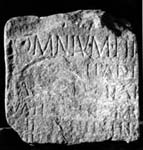Select a site alphabetically from the choices shown in the box below. Alternatively, browse sculptural examples using the Forward/Back buttons.
Chapters for this volume, along with copies of original in-text images, are available here.
Object type: Cross-slab, in two pieces
Measurements:
Fragment a: H. 86.4 cm (34 in); W. 53 cm (20.9 in D. Built in
Fragment b: H. 14 cm (5.5 in); W. 58.5 cm (23 in) D. 55 cm (21.75 in)
Stone type: Coarse-grained, massive yellow sandstone
Plate numbers in printed volume: Pls. 95.518, 96.519-520, 97.521
Corpus volume reference: Vol 1 p. 112-113
(There may be more views or larger images available for this item. Click on the thumbnail image to view.)
Incomplete upright slab, originally fashioned in three parts from reused Roman stones.
A (broad): The upper part of the cross is missing, but the horizontal arms have survived on the side of a Roman inscribed stone (b). A heavy cable moulding survives on the right side of b and on the left side of a, the opposite side having been broken away in both. The cross, which fills the frame, is type A2 (see Jarrow 10). The lower arm is attached to a waisted upright with a splayed foot. The cross is outlined by a raised roll moulding. There are signs of fine diagonal tooling below the base of the cross. In the lower quadrants of the cross is a Latin inscription in seriffed Anglo-Saxon capitals from which only a few letters are missing on the right side:
[INHO] II [CSI.—
GVLA II R [—
NOVI II TAR[E.—
DITVR II MVN[DO —
(b): E (top): Traces of Roman inscription.
(b): F (bottom): Recut.
When first noted by Brand (1789), the inscription restored as `singulari anno'. The rendering with anno produced the theory that the cross was set up as a thanksgiving after the plague which devastated the monastery soon after its foundation; this event could have warranted some corporate inscription. It is more convincingly restored as first suggested by Hübner (1876):
IN HOC SINGULARI SIGNO VITA REDDITUR MUNDO (Translation: `In this unique sign life is returned to the world').
Levison's suggestion that the first four words were possibly taken from the translation of Eusebius by Rufinus and refer to Constantine's dream of the cross produces the acceptable idea that at Jarrow there was a special devotion to the cross. Such devotion to the cross as the sign of victory, would be fitting for this monastery (Introduction, p. 5), and readers of the text would be expected to recall the story of Constantine's victory using this potent symbol.
In the shape and deep style of carving the cross is like that on Monkwearmouth 5, but the outline moulding and the curving shaft of the Jarrow cross is less confident than Monkwearmouth. The stone is cut in several parts, at least one of them, b, of great depth, and was clearly built into a wall like the church dedication stone, no. 17 (erected in 685), which also is in two parts. Its script is also very like that of the dedication stone and the uncarved base is like several of the architectural frieze (e.g. no. 27). Higgitt (1979) puts this slab earlier than Monkwearmouth 5 and dates it early eighth century However, it could have been one of the original fitment of the church.



